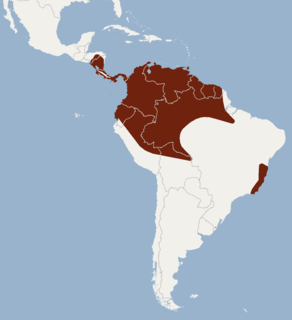Anderson's gerbil is a species of rodent distributed from Tunisia to Israel. Their habitats and diets are similar to other gerbils. The gestation period is 20–22 days and the average litter size is four or five. The IUCN formerly listed the junior synonym Gerbillus allenbyi as vulnerable.

Nepenthes hispida is a tropical pitcher plant species native to Borneo. It grows at elevations of 100 to 800 m in kerangas forest. It is known with certainty only from Lambir Hills National Park and surrounding areas.

The hairy big-eared bat is a bat species from South and Central America, as well as Trinidad and Tobago in the Caribbean.
Aiphanes hirsuta is a species of flowering plant in the family Arecaceae. It is found in Colombia, Costa Rica, Ecuador, and Panama.
Wettinia aequatorialis is a species of flowering plant in the family Arecaceae. It is commonly found in the country of Ecuador; more specifically the southern part. Its natural habitat is subtropical or tropical moist montane forests. This species is threatened by habitat loss.
Wettinia is a palm genus, consisting of flowering plants in the family Arecaceae. The genus, established in 1837, contains some 20 species, but more seem to await discovery considering that 4 species - W. aequatorialis, W. lanata, W. minima and W. panamensis - were described as late as 1995. The genus is broadly divided into two groups. One group has the fruits tightly packed, while the other, formerly classified as genus Catoblastus, has fruits scattered along the inflorescence branches. It is not known whether these groups are both monophyletic. The genus is named after Frederick Augustus II of Saxony, of the House of Wettin.
Wettinia anomala is a species of flowering plant in the family Arecaceae. It is found in Colombia and Ecuador.
Wettinia disticha is a species of flowering plant in the family Arecaceae. It is found only in Colombia.
Wettinia drudei is a species of flowering plant in the family Arecaceae. It is found in Brazil, Colombia, Ecuador, and Peru.
Wettinia fascicularis is a species of flowering plant in the family Arecaceae. It is found in Colombia and Ecuador.
Wettinia kalbreyeri is a species of flowering plant in the family Arecaceae. It is found in Colombia and Ecuador. The plant is named after the Victorian plant collector, Guillermo Kalbreyer. It is commonly called the macana palm.
Wettinia longipetala is a species of tree in the family Arecaceae. It is found only in Peru, and is considered a vulnerable species by the IUCN.
Wettinia minima is a species of flowering plant in the family Arecaceae found only in Ecuador. Its natural habitat being subtropical or tropical moist montane forests, it is threatened by habitat loss.
Campomanesia hirsuta is a species of plant in the family Myrtaceae. The plant is endemic to the Atlantic Forest ecoregion of southeastern Brazil, within Rio de Janeiro state. It is an IUCN Red List Endangered species, threatened by habitat loss.
Ficus hirsuta is a species of plant in the family Moraceae. It is endemic to Brazil.
Rinorea hirsuta is a species of plant in the Violaceae family. It is found in Colombia and Panama.
Rondeletia hirsuta is a species of plant in the family Rubiaceae. It is endemic to Jamaica. It is threatened by habitat loss.
Dactyladenia hirsuta is a species of plant in the family Chrysobalanaceae. It is endemic to Ivory Coast and Ghana. Its natural habitats are wet evergreen forests. It is threatened by extensive logging of its habitat, the effects of mining and the establishment of commercial plantations.
Diospyros hirsuta is a tree in the ebony family endemic to Sri Lanka.

The hairy saki is a species of saki monkey, a type of New World monkey. It is found in northern Peru, southern Colombia, and a small portion of northwestern Brazil.



